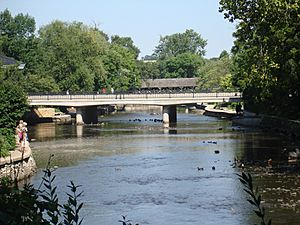DuPage River facts for kids
Quick facts for kids DuPage River |
|
|---|---|

Warrenville Grove Forest Preserve on the West Branch of the DuPage River, where Julius Warren claimed land in Warrenville in 1833.
|
|
| Physical characteristics | |
| Main source | Confluence of the East Branch and West Branch in Bolingbrook, Illinois 41°42′07″N 88°08′51″W / 41.7019745°N 88.1475649°W |
| River mouth | Confluence with the Des Plaines River near Channahon, Illinois 502 ft (153 m) 41°24′56″N 88°13′10″W / 41.4155866°N 88.2195063°W |
| Length | 28.3 mi (45.5 km) |
| Basin features | |
| Progression | DuPage River → Des Plaines → Illinois → Mississippi → Gulf Mexico |
| GNIS ID | 407441 |
The DuPage River is a 28.3-mile (45.5 km) long river in Illinois, United States. It is a tributary of the Des Plaines River. This means it flows into the Des Plaines River, which then flows into bigger rivers like the Illinois River and the Mississippi River. Eventually, its water reaches the Gulf of Mexico.
Contents
Where Does the DuPage River Flow?
The DuPage River actually starts as two separate streams. These are called the West Branch and the East Branch.
The West Branch
The West Branch of the DuPage River is about 35 miles (56 km) long. It begins in Schaumburg, which is in Cook County. From there, it flows south through all of DuPage County.
Some of the towns it passes through include Bartlett, Wheaton, Warrenville, Winfield, and Naperville. You can even see it flowing through the popular riverwalk in Naperville!
The East Branch
The East Branch of the DuPage River is about 25 miles (40 km) long. It starts in Bloomingdale. This branch also flows south, passing through several towns.
These towns include Glendale Heights, Glen Ellyn, Lisle, Woodridge, and parts of Naperville and Bolingbrook. A smaller stream called St. Joseph Creek also joins the East Branch.
Where the Branches Meet
The two branches of the DuPage River meet between Naperville and Bolingbrook. After they join, the combined DuPage River continues flowing south. It passes through Plainfield and Shorewood. Then, it flows west of Joliet.
Further downstream, near Channahon, there is a dam on the river. This dam was built a long time ago. Its purpose was to raise the river's water level. This helped to feed water into the Illinois and Michigan Canal, which was an important waterway for boats and trade. Finally, from Channahon, the DuPage River flows into the Des Plaines River.
What About Flooding?
Like many rivers, the DuPage River can sometimes overflow its banks. This is called flooding. Both branches of the DuPage River experienced serious flooding in 1996. This event is often called the "Flood of 1996."
The Flood of 1996
During the "Flood of 1996," about 17 inches (43 cm) of rain fell in the area. This huge amount of rain fell in just 24 hours, on July 18–19, 1996. This caused the river to rise very high.
Some roads, like Washington Street in Naperville and Illinois Route 53 in Glen Ellyn, often flooded. This happened because these roads are very close to the river branches. To help with this, the City of Naperville removed many homes and businesses that were affected by the floods. DuPage County also removed many affected homes in Glen Ellyn, with help from the U.S. Department of Transportation.
How Flooding is Managed Now
In 2009, a new dam was built on the river. This new dam has been very helpful. It allows people to better control the river's water level. This helps to prevent or reduce flooding in the future.
How Did the DuPage River Get Its Name?

The name "DuPage River" has a long history! The first written history about the name comes from an 1882 book called History of DuPage County, Illinois.
This book explains that the river was known by this name for a very long time. It got its name from a French trader. This trader settled on the river, below where the two branches meet, even before the year 1800.
People who lived in the area a long time ago, like J. B. Beaubien and Col Gurden S. Hubbard, talked about this French trader. They said his name was Du Page, and his trading post was near the river's mouth. That's why the river, and later the county, were named after him.
The name "Du Page" is pronounced "Du Pazhe."

